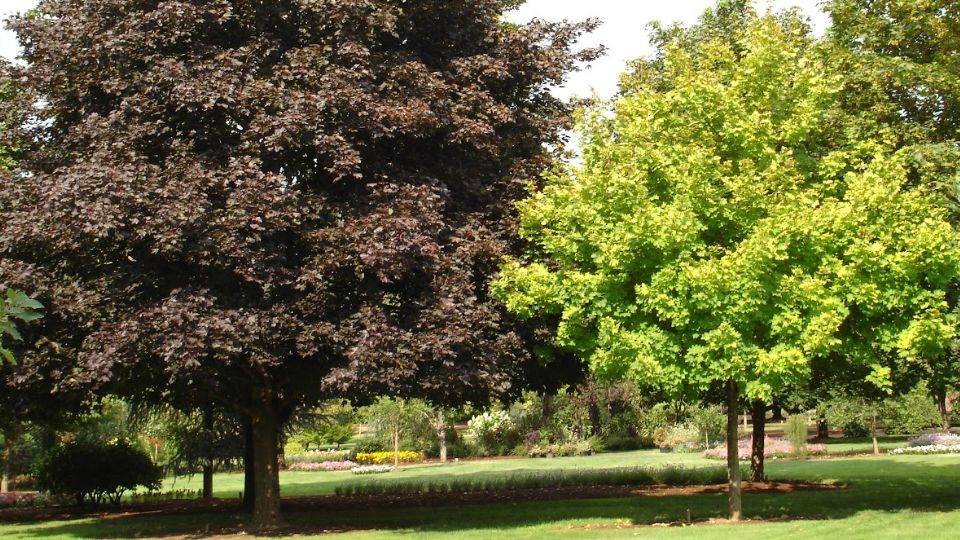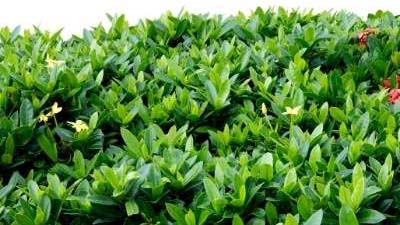Designing a Low Water Use Landscape

A landscape design should meet the needs of the people who will use and maintain the area while incorporating the site’s existing environmental conditions into the design. Water is a limiting resource in Utah, so designing the landscape to efficiently use water is important.
Conserving water in the landscape can be accomplished by selecting low water use plants, designing and scheduling irrigation systems efficiently, grouping plants according to their water requirements, and using hardscaping materials (patios, stone paths, decks, etc.) appropriately to reduce the area requiring irrigation.
Developing A Plot Plan
Develop a plot plan of the area to be landscaped. This is simply a map of the building and lawn along with the location of existing structures, trees and shrubs, property lines, driveways, gardens, utility lines, contours of the land, or other possible limitations to the design. Use graph paper to prepare a scale map of the property and let each square represent a certain distance.
Conducting a Site Analysis
Visit the site to look for the environmental assets and constraints that will influence the design. Take notes on such factors as seasonal effects of sun and shade, soil conditions, slopes, direction of winds, and views from various points on the site.
Planning the Design
Based on the environmental considerations found in the site analysis, decide where plants should be placed for optimum aesthetic value, screening of undesirable views, shade or windbreaks, and separation of areas of the yard. Consider the use of hardscaping materials such as patios, walks, screens, and lighting. These materials can enhance the design while reducing the amount of area that needs to be irrigated and maintained.
Conserving energy
Deciduous trees should be placed on the south, east and west sides of the building to take advantage of the potential benefits of summer shade and winter sun to heat or cool the building. Evergreens are good insulators but limit sunlight, so try to plant them on the north side of the building. In order to protect a home from cold and snow, use trees and shrubs as insulators or windbreaks along the building.
Conserving water
When choosing plants, identity their water requirements and group those with similar irrigation requirements in the same area or irrigation zone. This will help to more accurately meet plant water needs while conserving water. Zones can be separated into zone 0 (no irrigation), zone 1 (irrigate monthly), zone 2 (irrigate twice per month), zone 3 (irrigate weekly) and zone 4 (irrigate twice per week). Plants adapted to the dry conditions of Utah will survive with little or no water (zone 0). It is important to know the water requirements of the plants at the site to most efficiently meet these needs without wasting water. The watering zone designs will depend on the amount of water you wish to use for the landscape, how much money you can spend on landscape water, and what you wish to achieve aesthetically and environmentally.
Selecting the Plant Material
Select plant materials that will most effectively achieve your design goals. When possible, use plant species that are adapted to the landscape environment—the soil, water, temperature, light, and pest conditions—to help minimize maintenance and water requirements. The following are some factors to consider when choosing plant materials.
Aesthetics
Choose plants based on height, width, shape, color, and form that will best help accomplish the design goals.
Function
Plants can be used to conserve energy or water (as discussed above) as well as to block undesirable views or noise (taller, more dense plant material), and control erosion on steep slopes (lower growing, ground covers).
Soils
Most plants do well under a range of soil conditions, however, many plants have an optimum pH range, salt tolerance level, and soil moisture requirement. In choosing plants for Utah, remember that most soils have an alkaline (high) pH and some have moderate to high salt levels. Consider a basic soil test to define soil conditions and identify soil problems or limitations before selecting plants.
Water
Since Utah receives a limited amount of annual rainfall, use plants that reflect this water situation. Select low water use plants and plants adapted to the region to increase their chances of survival and help conserve water. Also, try to incorporate smaller plants into the design, since they tend to have lower water requirements than larger plants. Consult your local nursery/greenhouse business or Utah State University County Extension Agent for information on low water use plants for your area.
Hardiness Zone
Plant hardiness zones in Utah range from 4-7. The hardiness zones were established by the USDA and are based on the minimum, annual survival temperatures for plants. Plants for hardiness Zone 4 can survive -20 to -30 °F, Zone 5 can survive -10 to -20 °F, Zone 6 can survive 0 to -10 °F and Zone 7 can survive 0 to 10 °F. However, micro-environments created by the plant’s surroundings can also influence its hardiness for the region. Contact your local Utah State University County Extension Agent to learn the hardiness zone of your area.
Principles of Design
There are several basic principles of design to consider when planning the landscape. Along with the ones listed below, remember the importance of simplicity and harmony in designing.
Balance
Balance can be symmetrical or asymmetrical. Symmetrical is a more formal style of design with materials on one side mirrored on the other. Asymmetrical balance can be achieved by using different elements to create a more informal equilibrium. This may require using a group of smaller shrubs to counterbalance a large tree on the opposite side.
Unity
Group plants to achieve a unifying effect in the landscape (usually in groups of 3, 5, or 7). Plants can be grouped according to color, texture, or form. However, some variety in color, plant material, hardscaping textures, etc., adds interest to the landscape.
Rhythm
Repetition of elements (colors, textures, plant form) in the landscape provides a feeling of continuity and helps lead the eye through the landscape.
Accent
Accent is also referred to as dominance. Balance and rhythm can help lead the eye through the design to the focal point (accent). Examples of focal points may be a building, large tree or bed of bright flowers in front of a row of green shrubs.
Designing a low water use landscape is an enjoyable experience that will provide you with a landscape that meets your expectations and also helps to conserve water and other resources. Using the design plans and principles outlined in this bulletin will help you to achieve the low water use landscape that you desire.
Reference
Keanne, T. Water-wise Landscaping. 1995. Utah State Univ. Cooperative Extension Service. http://extesnion.usu.edu/pblica/gardpubs/waterwis.pdf.htm
Published August 2002
Utah State University Extension
Peer-reviewed fact sheet
Download PDF
Authors
Teresa Cerny, Ornamental Horticulture Specialist; Kelly L. Kopp, Water Conservation and Turfgrass Specialist; Maggie Wolf, Salt Lake County Extension Horticulture Agent; Debbie Amundsen, Davis County Extension Horticulture Agent
Related Research






